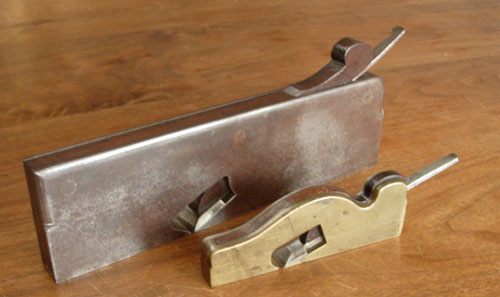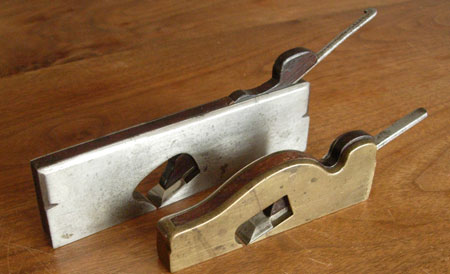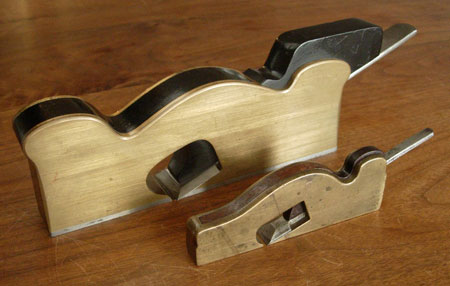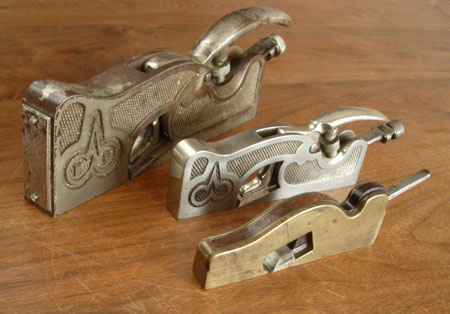|
|
04/27/2009 And the differences between shoulder planes and rabbet planes |
 With one exception every metal plane design I know of has a precedent in a wooden plane design. The exception is the shoulder plane. There is no wooden version of a shoulder plane. There are wooden (and metal) rabbet planes, and a wooden rabbet plane can do some of what you can do with a shoulder plane - but it's not the same thing. There are two major differences between a shoulder plane and a rebate (wood or metal) plane: With one exception every metal plane design I know of has a precedent in a wooden plane design. The exception is the shoulder plane. There is no wooden version of a shoulder plane. There are wooden (and metal) rabbet planes, and a wooden rabbet plane can do some of what you can do with a shoulder plane - but it's not the same thing. There are two major differences between a shoulder plane and a rebate (wood or metal) plane:
The first different is a lower bed angle and hopefully a very fine mouth. This makes a shoulder plane great for trimming shoulders, and of course the low angle bed is hard to make in wood. The wooden rabbet plane is designed for making and tuning rabbets so a slightly wider mouth for a thicker shaving and a higher bed angle for planing tricky grain is more useful. That it can be used for shoulders is just a bonus.
The second major difference is the horns, bumps, and other finger holds that you find on a shoulder plane. Rabbet planes are typically rectilinear in shape. The reason for all these finger holds and shapes on a shoulder plane is that unlike a rabbet plane which is normally used for forming rabbets and needs power, for odd shoulders with potentially weird clamping requirements you want a plane that you can grab at any angle and exercise a lot of control when using it. This is a plane that can be easily used on half a shoulder and then reversed and used on the other half in the other direction so that it doesn't split off a shoulder end.
The metal, infill rebate plane was first made in quantity sometime in the 1820's or 30's by Robert Towell of London. It's a square plane, usually at lower angle than a wooden version, with a tight mouth. Towell planes have a overall low profile. Around the 1850's somebody figured out that if you take the rebate design and round it out and cut into it you have a much better shape for fine dexterous work like trimming shoulders. At the same time the bed angle gets even lower and the shoulder plane was born. James Syme of London, was probably the first maker of shoulder planes. In the foreground above is a very small shoulder plane by Syme. Behind it is an earlier (and larger) rebate plane by Robert Towell. The Syme plane is cast and is in poor condition, with a broken off strike button in the back and someone opened the mouth of the plane into a real chasm. The wedge on the other hand is still beautifully fitted, basically flush with the plane body when the wedge is tight. You can kind of see how this early shoulder plane takes the basic low iron rebate and cuts finger holds into it.
 In the second picture we see the Syme shoulder plane next to a similar size (1/2" ) Spiers rebate plane. With the shoulder plane now invented for finesse, the rebate plane seems to grow in height, and it becomes even boxier. 1/2" shoulder planes are very rare and rebate planes are fairly rare and while both Spiers and Norris list rebate planes in their catalogs all through their histories in general they are much less common than shoulder planes. In the second picture we see the Syme shoulder plane next to a similar size (1/2" ) Spiers rebate plane. With the shoulder plane now invented for finesse, the rebate plane seems to grow in height, and it becomes even boxier. 1/2" shoulder planes are very rare and rebate planes are fairly rare and while both Spiers and Norris list rebate planes in their catalogs all through their histories in general they are much less common than shoulder planes.
 Spiers took the shoulder plane and gave it even rounder curves, and there are many different variations over time, by many makers. In the third picture we have the Syme plane next to a 1 1/4" C. 1930 cast Norris shoulder plane (model 20E) in the classic London style. There is a certainly 20th century restraint about the design but the longer wedge is typical of the London style. The 1 1/4" size is the most common size found. Spiers took the shoulder plane and gave it even rounder curves, and there are many different variations over time, by many makers. In the third picture we have the Syme plane next to a 1 1/4" C. 1930 cast Norris shoulder plane (model 20E) in the classic London style. There is a certainly 20th century restraint about the design but the longer wedge is typical of the London style. The 1 1/4" size is the most common size found.
Finally we have the Syme next to two Preston (c. 1910-1920) adjustable shoulder planes. Preston was the first maker of shoulder planes to offer an adjuster and they also cast in a nice burlap pattern at the back of the plane so that it can be easily gripped and pulled. The pull stroke on a shoulder plane gives you  more control and is much more comfortable than a push stroke. The Syme plane also works comfortably when pulled. more control and is much more comfortable than a push stroke. The Syme plane also works comfortably when pulled.
The planemaking departments of Preston were purchased by Record in the 1930's. Record stopped making shoulder planes in the 1990's. While the function was kept Record planes had far less ornamentation than the Preston models. Click here for more information on Record Planes. The Preston designs form the basis for the shoulder planes made by Clifton which can be seen here.
For (lots) more on shoulder planes please visit our old exhibit (from 1996) at The Museum of Woodworking Tools.
|
Join the conversation |
|
 Joel's Blog
Joel's Blog Built-It Blog
Built-It Blog Video Roundup
Video Roundup Classes & Events
Classes & Events Work Magazine
Work Magazine


 With one exception every metal plane design I know of has a precedent in a wooden plane design. The exception is the shoulder plane. There is no wooden version of a shoulder plane. There are wooden (and metal) rabbet planes, and a wooden rabbet plane can do some of what you can do with a shoulder plane - but it's not the same thing. There are two major differences between a shoulder plane and a rebate (wood or metal) plane:
With one exception every metal plane design I know of has a precedent in a wooden plane design. The exception is the shoulder plane. There is no wooden version of a shoulder plane. There are wooden (and metal) rabbet planes, and a wooden rabbet plane can do some of what you can do with a shoulder plane - but it's not the same thing. There are two major differences between a shoulder plane and a rebate (wood or metal) plane: In the second picture we see the Syme shoulder plane next to a similar size (1/2" ) Spiers rebate plane. With the shoulder plane now invented for finesse, the rebate plane seems to grow in height, and it becomes even boxier. 1/2" shoulder planes are very rare and rebate planes are fairly rare and while both Spiers and Norris list rebate planes in their catalogs all through their histories in general they are much less common than shoulder planes.
In the second picture we see the Syme shoulder plane next to a similar size (1/2" ) Spiers rebate plane. With the shoulder plane now invented for finesse, the rebate plane seems to grow in height, and it becomes even boxier. 1/2" shoulder planes are very rare and rebate planes are fairly rare and while both Spiers and Norris list rebate planes in their catalogs all through their histories in general they are much less common than shoulder planes.  Spiers took the shoulder plane and gave it even rounder curves, and there are many different variations over time, by many makers. In the third picture we have the Syme plane next to a 1 1/4" C. 1930 cast Norris shoulder plane (model 20E) in the classic London style. There is a certainly 20th century restraint about the design but the longer wedge is typical of the London style. The 1 1/4" size is the most common size found.
Spiers took the shoulder plane and gave it even rounder curves, and there are many different variations over time, by many makers. In the third picture we have the Syme plane next to a 1 1/4" C. 1930 cast Norris shoulder plane (model 20E) in the classic London style. There is a certainly 20th century restraint about the design but the longer wedge is typical of the London style. The 1 1/4" size is the most common size found.  more control and is much more comfortable than a push stroke. The Syme plane also works comfortably when pulled.
more control and is much more comfortable than a push stroke. The Syme plane also works comfortably when pulled.
I am happy to see that you now have an rss feed on your blog. I just added it to my aggregator so my readers can see the headline and click over to your site and read the article. Let me know if you ever have any questions, concerns or comments.
Luke